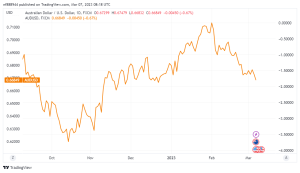On Tuesday, the AUDUSD pair draws some selling for the second day in a row and hits a new two-month low. After Reserve Bank of Australia (RBA) published its policy decision.
A bullish risk tone weakens the safe-haven buck and helps the Australian contain losses.
Nevertheless, spot prices remain resilient below the 0.6700 level. As traders are hesitant to put aggressive wagers ahead of Fed Chair Jerome Powell’s semi-annual congressional appearance. Powell’s remarks will be widely studied for hints regarding the Fed’s future rate-hike pace. Which will in turn influence the near-term USD price dynamics. This week, investors will also face the publication of the carefully awaited US monthly jobs statistics. Generally known as the as of Friday’s NFP. This should contribute to the AUDUSD pair gaining some substantial momentum. Yet, the underlying background favors a prolongation of the weakening trend seen over the last month or two.
The RBA raises rates by 25 basis points and implies additional rises, but this does not excite optimistic traders.
The RBA lifted its overnight cash rate by 25 basis points to 3.6%, the most since June 2012. And suggested that additional rises were needed to keep inflation under control. But RBA Governor Philip Lowe emphasized in the accompanying policy statement that the route to a gentle landing for the Australian economy remains limited. This has fueled speculation that the economy could enter a recession over the next 24 months. Which, together with the announcement of Australia’s trade balance figures, has weighed on the home currency. Yet, a generally upbeat tone in the equity markets weakens the safe-haven US Dollar and gives some support to the risk-sensitive Australian dollar.
The market’s attention is still focused on Fed Chair Powell’s semi-annual congressional testimony.
Meanwhile, the USD’s decline is being cushioned by widespread consensus that the Federal Reserve would maintain its hawkish posture. And keep interest rates higher for longer in order to contain persistently high inflation. Furthermore, recent US macro data suggested that inflation is not falling as quickly as expected, pointing to an economy. That remains robust despite higher borrowing costs. This should allow the Federal Reserve of the United States to continue tightening monetary policy at a quicker rate. Additionally, a wave of FOMC officials recently reinforced the argument for higher rate rises, opening the door to a 50-basis point increase at the end of the year. Later this month, there will be a policy meeting. This supports rising US Treasury bond rates. Which, together with concerns of a deeper global economic crisis, favors USD bulls and implies that the AUDUSD pair’s path of least resistance remains to the negative.
AUDUSD Technical Outlook
Acceptance below the 0.6700 level may be considered as a new signal for bearish traders in light of the previous breach below a theoretically crucial 200-day Simple Moving Average (SMA). Also, oscillators on the daily chart are deep in negative territory and remain distant from being oversold. As a result, a following drop towards the 0.6660 zone, or the 50% Fibonacci retracement level of the rise from the October 2022 low, on the way to the 0.6600 level, appears to be a strong possibility.
The latter should serve as a solid foundation for the AUDUSD pair, limiting additional losses for the time being.

On the other hand, any genuine recovery effort may continue to draw new supply near the resistance zone is 0.6770-0.6780. The AUDUSD pair should be capped at the 0.6800 confluence support breakpoint, which includes the 200-day SMA and the 38.2% Fibo. level. But some follow-through buying might spark a short-covering rally, lifting spot prices to the next key obstacle between 0.6875-0.6880. This is followed by the 0.6900 level and the 23.6% Fibo. level, which, if strongly passed, might tilt the near-term bias in favor of bullish traders.









